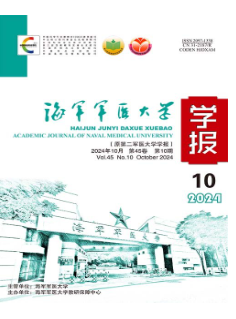2019冠状病毒病患者的中医辨证
Q4 Medicine
引用次数: 0
摘要
目的探讨新型冠状病毒病(COVID-19)患者的中医辨证规律。方法采用横断面调查法收集湖北省广谷妇幼保健院756例新冠肺炎患者的症状。采用频率法记录症状在不同病程的发生率:前驱期(发病)、中期(7 ~ 30 d)、晚期(10 ~ 30 d)。采用系统聚类分析常见症状(发病率>5.0%)。结合专家经验,总结新冠肺炎患者中医辨证规律。结果本病前驱期(756例)以发热(52.25%,395例)、咳嗽(43.25%,327例)、乏力(27.25%,206例)、胸闷(26.72%,202例)、哮喘(17.59%,133例)、咳痰(5.03%,38例)为最常见症状,除咳痰外均聚为一类,提示肺、体表湿抑均为发病机制。中期(383例),19种常见症状包括毛油腻(64.49%,247例)、毛黄(43.86%,168例)、毛厚(40.21%,154例)、咳嗽(34.73%,133例)、舌红(32.38%,124例)、大便不畅(25.85%,99例)、哮喘(25.33%,97例)、乏力(25.07%,96例)、食欲不佳(23.76%,91例)、口苦(14.36%,55例)、毛干(12.01%,46例)、舌紫(12.01%,46例)、出汗(11.49%,44例)、便秘(10.18%,168例)。其中痰白(8.62%,33例)、失眠(7.31%,28例)、恶心(7.05%,27例)、腹泻(6.79%,26例)、黄痰(6.27%,24例)为3组,提示病机以湿热积存、湿阻肺脾、湿热燥为主。晚期(373例)13种常见症状为毛油腻(50.94%,190例)、乏力(39.41%,147例)、咳嗽(37.80%,141例)、舌红(33.78%,126例)、哮喘(32.17%,120例)、出汗(23.86%,89例)、口干(22.79%,85例)、食欲不振(20.11%,75例)、大便不畅(19.30%,72例)、口苦(15.01%,56例)、痰白(10.72%,40例)、心悸(8.31%,31例)、毛少(8.04%,30例)。分为两组,提示气阴虚湿型病机和肺气脾虚湿型病机。结论新冠肺炎不同分期中医证候具有自身的典型特征,由外证到内证、由湿证到湿热证、由虚证到虚证的变化规律明显。本文章由计算机程序翻译,如有差异,请以英文原文为准。
Traditional Chinese medicine syndrome differentiation of coronavirus disease 2019 patients
Objective To explore the rule of traditional Chinese medicine (TCM) syndrome differentiation of coronavirus disease 2019 (COVID-19) patients. Methods The symptoms of 756 cases with COVID-19 in Guanggu Branch of Maternity and Child Healthcare Hospital of Hubei Province were collected by cross sectional survey. The incidence rates of the symptoms were recorded by frequency method at different courses of the disease: prodromal stage (onset), middle stage (7-30 days), and later stage (>30 days). The common symptoms (incidence rate>5.0%) were analyzed by systematic clustering. With expert experience, the rule of TCM syndrome differentiation of COVID-19 patients was summarized. Results Fever (52.25%, 395 cases), cough (43.25%, 327 cases), asthenia (27.25%, 206 cases), chest distress (26.72%, 202 cases), asthma (17.59%, 133 cases) and expectoration (5.03%, 38 cases) were the most common symptoms in the prodromal stage (756 cases) of the disease, which were clustered into one category except expectoration, indicating the pathogenesis of both lung and body surface suppressed by dampness. In the middle stage (383 cases), the 19 common symptoms including greasy fur (64.49%, 247 cases), yellow fur (43.86%, 168 cases), thick fur (40.21%, 154 cases), cough (34.73%, 133 cases), red tongue (32.38%, 124 cases), poor stool (25.85%, 99 cases), asthma (25.33%, 97 cases), asthenia (25.07%, 96 cases), poor appetite (23.76%, 91 cases), bitterness of mouth (14.36%, 55 cases), dry fur (12.01%, 46 cases), purple tongue (12.01%, 46 cases), perspiration (11.49%, 44 cases), constipation (10.18%, 39 cases), white phlegm (8.62%, 33 cases), insomnia (7.31%, 28 cases), nausea (7.05%, 27 cases), diarrhea (6.79%, 26 cases) and yellow phlegm (6.27%, 24 cases), were clustered into three groups, indicating the pathogenesis of damp-heat accumulation, obstruction of lung and spleen by dampness, and dryness due to dampness-heat. In the later stage (373 cases), the 13 common symptoms including greasy fur (50.94%, 190 cases), asthenia (39.41%, 147 cases), cough (37.80%, 141 cases), red tongue (33.78%, 126 cases), asthma (32.17%, 120 cases), perspiration (23.86%, 89 cases), dry mouth (22.79%, 85 cases), poor appetite (20.11%, 75 cases), poor stool (19.30%, 72 cases), bitterness of mouth (15.01%, 56 cases), white phlegm (10.72%, 40 cases), palpitation (8.31%, 31 cases) and little fur (8.04%, 30 cases), were clustered into two groups, indicating the pathogenesis of deficiency of Qi and Yin with residual dampness, and deficiency of lung Qi and spleen Qi with residual dampness. Conclusion The TCM syndromes of COVID-19 patients in different stages have its own typical characteristics, with a regular change from exterior to interior, from dampness to dampness-heat and from excess to deficiency..
求助全文
通过发布文献求助,成功后即可免费获取论文全文。
去求助
来源期刊

海军军医大学学报
Medicine-Medicine (all)
CiteScore
0.50
自引率
0.00%
发文量
14752
期刊介绍:
Founded in 1980, Academic Journal of Second Military Medical University(AJSMMU) is sponsored by Second Military Medical University, a well-known medical university in China. AJSMMU is a peer-reviewed biomedical journal,published in Chinese with English abstracts.The journal aims to showcase outstanding research articles from all areas of biology and medicine,including basic medicine(such as biochemistry, microbiology, molecular biology, genetics, etc.),clinical medicine,public health and epidemiology, military medicine,pharmacology and Traditional Chinese Medicine),to publish significant case report, and to provide both perspectives on personal experiences in medicine and reviews of the current state of biology and medicine.
 求助内容:
求助内容: 应助结果提醒方式:
应助结果提醒方式:


